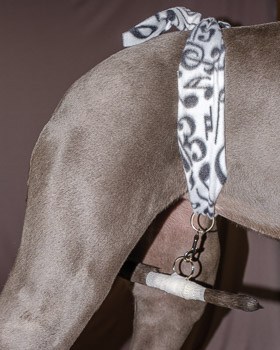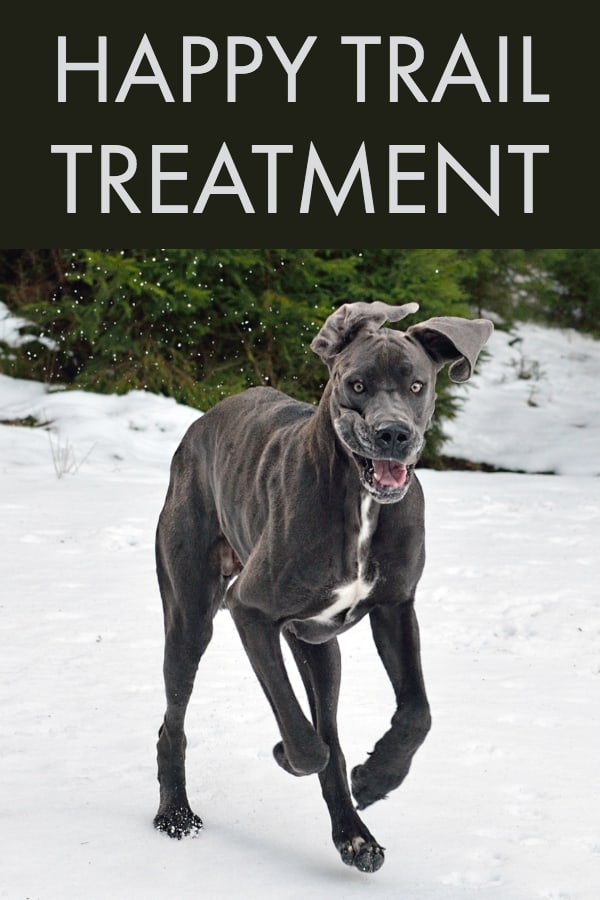
If you’ve been lucky enough to spend any amount of time around a Great Dane then it’s very likely you’ve noticed one thing – they have very strong tails! Given their friendly nature, it doesn’t take much to get their tails wagging with excitement.
As lovable as this may be, all of this excessive wagging can eventually lead to a damaged and split tail. Known as “happy tail syndrome”, it can lead to not so happy outcomes.
In the worst cases, amputation is necessary to prevent further damage to the tail. However, the good news is that you can avoid this sad ending by employing the sling method shown below.
Why do Great Danes get happy tail syndrome?
Aside from their lovable nature, Great Danes have smooth thin tails that don’t provide much natural protection against hard surfaces that they may collide with during wagging.
Repeated collisions with these hard surfaces e.g. walls, crates, table legs, etc… can lead to damage at the tip of the tail during a few excited wags, or over time with repeated collision.
Great Danes aren’t the only ones affected by this syndrome as it’s also commonly seen in breeds such as Greyhounds, Pitbulls, Dalmations, Pointers, Dobermans, and Boxers.
Note how the similarity in coats between these larger (and stronger) breeds places them at an increased risk for experiencing Happy Tail syndrome.
Historically, tail docking was often performed not long after birth for some of these breeds to avoid future damage to the tail. Along with ear cropping, tail docking is seen as a controversial practice in today’s world and even banned in certain countries.
How do I know if my Great Dane has happy tail syndrome?
The beginning stages of happy tail syndrome may be noted by bald spots, your Great Dane biting, or visibly raw patches on the tip of the tail. However, in most cases it’s accompanied by an open wound that bleeds anywhere from a little to a lot.
Some owners have even reported coming home to a horror film like scene where their Danes bleeding tail have wiped blood all over their walls.
It is important to begin treating a damaged tail as soon as you notice it as it is a risk for infection and continued physical damage.
Treating Happy Tail Syndrome
Recovery from a damaged tail can take several weeks to fully heal, so the quicker you address the issue the better.
This is especially important as Great Danes who split open their tails once, are more likely to re-injure them.
Step 1: Clean the injured area
The area will first need to be cleaned to prevent infection. Depending on the severity, some wounds may require stitches to be closed up. Please consult with your veterinarian for proper care if you think it’s warranted.
- Start by gently cleaning the wounded area with medicated wipes or solution to remove potential contaminants. These include blood, dirt, or any other materials that may have become lodged in the area.
- Apply antibiotic ointment to the area to help prevent infection.
- Optionally make use of EMT gel to help seal up the wound. In addition to treating happy tail, EMT gel is also fantastic of sealing up other wounds such as a torn pad and a great item to have on hand at all times.
Step 2: Preventing re-injury during healing
Now that you’ve got the injured area cleaned up and ready to start healing, it will be vitally important to prevent them from re-injuring the area during healing.
This is best done by creating a sling that gently holds their tail between their legs to prevent it from whacking into hard surfaces. Credit for this method goes to GreatDaneLady where I first came across it.
Start by gathering the following supplies to create the tail sling:
- 1 – O-ring (~1 inch diameter)
- 1 – Swivel snap hook
- Soft breathable porous tape (1 inch wide)
- Soft cloth that’s 2-3 inches wide and long enough to fully wrap around the dog’s torso
Note: Do NOT use duct tape, masking tape, or other forms of non-breathable tape.

2. Use approximately one foot of tape to wrap a three inch section of the tail, just adjacent to the wounded section (closer to their rear end). Make sure to not wrap the tape too tightly as cutting off blood supply could cause them to lose a section of the tail.
Use an additional small piece of tape to adhere the o-ring on top of the previously taped section. Make sure to mount the o-ring on the underside of the tail so that it easily snaps into the swivel hook.

3. Slide the cloth through the anchor end of the swivel snap hook, and wrap around the dog’s torso near their rear end. Tie off the ends to hold in place such that it’s snug but still allows some room for movement.
4. Complete the sling by lifting the dog’s tail between their legs, and attaching the snap hook to the o-ring. This should keep their tail lifted safely out of place between their legs, and out of harm’s way during wagging.
By leaving some room for movement during the tie-off, it should allow room for the dog to move their tail to the side during urination. Keep an eye on the areas contacting the cloth to ensure that it’s not creating irritation.
You may need to either loosen the wrap, or change to a softer cloth material if does appear.

For more information about caring for a Great Dane, please make sure to consider my book “The Great Dane Puppy Handbook“.
The Great Dane Puppy Handbook takes all of the need-to-know Great Dane info and packages it together into a single, concise resource. Save yourself time, money, and frustration by avoiding the most common mistakes made by Great Dane owners!
Final Thoughts on Happy Tail
Keep in mind that it can take several weeks to a month for full healing to occur. Continue using the sling and monitor healing until it is 100% healed. This is extremely important as continued re-injury to the tail could lead to eventual tail amputation.
While the loss of a tail isn’t necessarily a life threatening event, its absence will impact them in other ways. For example, tails are a very useful social queue amongst dogs and could impact how your Great Dane interacts with new dogs.
It’s also very useful in helping them to maneuver while running or playing. Therefore, likely making them a tad more clumsy than before they lost their tail.
The good news is that by leveraging these simple steps you can hopefully avoid the pain, suffering, and messy cleanup associated with chronic Happy Tail Syndrome.



This is a great idea! I have been looking for a solution for my Dane. His tail is so sore and at very high risk to be amputated. Do you have any suggest to keep him from licking? I’ve tried the cone but he can still reach his tail even with the biggest one offered by the vet. I also tried a pair of woman’s maternity tights to tuck his tail down the leg… that works a bit, but if he’s left alone he can take them off easy. I’m looking for any suggestion.
Thanks!
Do you unclip it so they
Can go to the bathroom?
yes, you can unclip, but I’ve found my Dane can go to the bathroom with the sling on as long as the ring is positioned about 3-6″ from the end of the tail. She can move her tail to the side and still use the bathroom with no issues. This is great because one smack against anything can break open the wound again.
What if it is on the very top of the tail?
When I was a kid we had a Great Dane who kept breaking his wounded tail open. My dad, a surgeon, came up with a very simple solution. He put a plastic pill bottle on the tail. Then he wrapped a little adhesive tape around the open end, to keep it from falling off the tail. Perfectly safe as adhesive tape is used on human wounds. Just stand back when the dog wags his tail.
Brilliant!!!!
My Dane has been messing with his tail for a long time. I was treating it as a hot spot, but it finally started bleeding. I tried a cone, (both forward and backwards) an inflatable neck ring, putting his tail in a sling, and using all 3 together, with bitter apple/vinegar.
He is able to get to his tail somehow, and take everything off including the bandages. I have finally come to the conclusion that even if I was able to keep his tail away from him until it heals, he is almost certainly going to start messing with it again.
If anyone has any other suggestions please send them 🙁